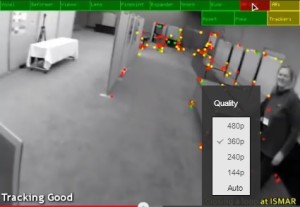MiniPTAM augmented reality software

Augmented reality (AR) combines a live view of a physical real-world environment combined with virtual, computer-generated images creating a mixed (augmented) view.
Annotated images in a TV programme (such as sports scoring) are an early example of AR. Current applications include the use of avatars placed in the real-world environment to offer advertisement or other information to the user.
The advent of smartphones, equipped with a camera, has provided a platform that can be exploited in a number or ways to deliver internet-based content to users in a novel and appealing way.
MiniPTAM provides augmentation on smart phones equipped with a camera that can generate a live video feed to the software.
The Oxford parallel tracking and mapping (PTAM) software is a camera tracking system that establishes a ground plane (or any other horizontal surface) in a real-world video feed, which can be used to supplement the live image with stable 3D augmentations.
The Oxford PTAM software requires no markers, pre-made maps, scene templates, or inertial sensors.
The core system is designed to track a hand-held camera in a small workspace. Tracking and mapping are processed in parallel – one thread deals with the task of robustly tracking erratic hand-held motion, while the other produces a 3D map of point features from previously observed video frames. This allows the use of batch optimisation techniques not usually associated with real-time operation.
The result is a system that produces detailed maps with thousands of landmarks which can be tracked at frame-rate, with an accuracy and robustness rivalling that of state-of-the-art model-based systems.
MiniPTAM provides augmentation on smart phones equipped with a camera that can generate a live video feed to the software. Phone cameras offer a narrow field-of-view that makes robust tracking harder. Slow frame rates result in significant motion blur, and the rolling shutter causes severe smearing effects.
MiniPTAM mitigates the impact of these deficiencies and is capable of generating maps for, and augmenting, simple scenes.
Request more information if you would like to discuss this further.
about this technology

